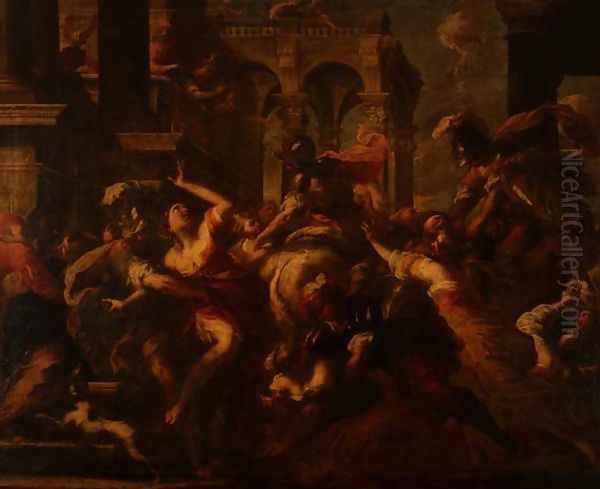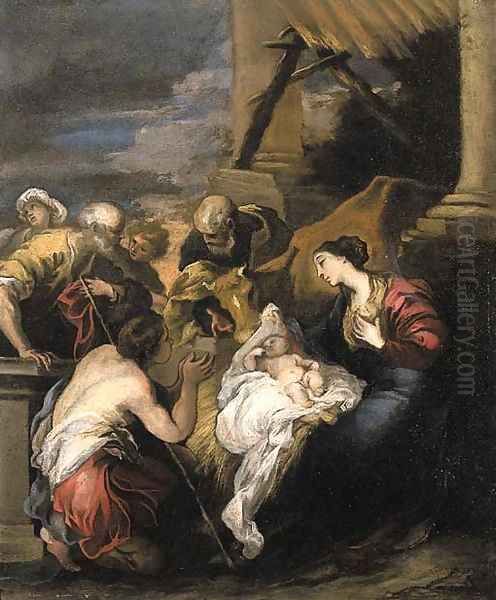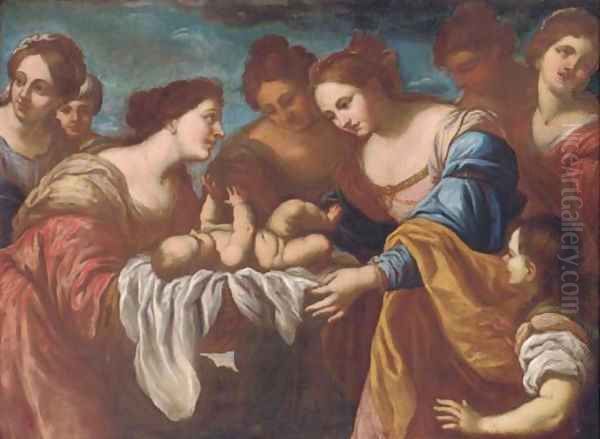Valerio Castello stands as a pivotal figure in the vibrant tapestry of 17th-century Italian art. A leading exponent of the Genoese Baroque school, his relatively short life, spanning from 1624 to 1659, was marked by intense creativity and the production of works renowned for their dynamism, rich colour, and emotional depth. Born and primarily active in Genoa, with significant periods of study and work in Milan and Parma, Castello forged a distinctive style that synthesized various powerful influences, leaving an indelible mark on the art of his time and influencing subsequent generations of painters in Liguria.
Early Life and Artistic Inclination
Valerio Castello was born into an artistic lineage in Genoa in 1624. He was the youngest son of Bernardo Castello, himself a respected painter, though perhaps more noted in his time than Valerio would become posthumously famous. Tragedy struck early in Valerio's life when his father passed away when the boy was merely six years old. This loss led to him being raised within the noble Torquato family, indicating his family's connections within Genoese society.
Initially, the path envisioned for the young Valerio was one of letters and literature, aligning with the expectations for a young man of his social standing. However, his innate predisposition towards the visual arts soon became undeniable. Encouraged perhaps by his late father's legacy or simply driven by an inner calling, he demonstrated a strong interest and talent for drawing and painting. This burgeoning passion eventually led him to abandon literary studies and dedicate himself fully to becoming an artist.
Formative Training in Genoa
Valerio Castello's formal artistic education began in his native Genoa. He sought out apprenticeships with prominent local masters who could guide his raw talent. His primary teachers were Domenico Fiasella, known as "Il Sarzana," a significant figure in the Genoese school, and Giovanni Andrea de Ferrari. Some sources also mention Andrea del Ferro in this context. These masters provided him with a solid foundation in drawing, composition, and the techniques prevalent in Ligurian painting.

Under the tutelage of Fiasella and De Ferrari, Castello absorbed the prevailing artistic currents of Genoa. This environment was already rich, having seen the work of earlier masters like Luca Cambiaso and being receptive to external influences, including Flemish artists who frequented the port city. This initial training grounded him in the local tradition but also prepared him to seek broader horizons and refine his burgeoning personal style.
Transformative Journeys: Milan and Parma
Seeking to expand his artistic vocabulary and expose himself to different schools of painting, Valerio Castello embarked on crucial study trips, notably to Milan and Parma, likely around the late 1640s. He often travelled with his friend, the painter Agostino Merano. These journeys proved immensely influential, allowing him to directly engage with the masterpieces of Lombard and Emilian art.
In Milan, Castello encountered the works of artists like Giulio Cesare Procaccini, whose elegant figures and emotional intensity resonated with him. The Lombard school's emphasis on expressive pathos and sophisticated composition offered new perspectives. His time in Parma was perhaps even more transformative. There, he immersed himself in the art of Correggio and Parmigianino. Correggio's mastery of soft sfumato, dynamic movement (especially in dome frescoes), and tender sentiment left a profound impact. Parmigianino's elongated, graceful figures and sophisticated Mannerist elegance also informed Castello's developing aesthetic.
These experiences outside Genoa were critical. They allowed Castello to break free from purely local conventions and integrate the grace of Correggio, the drama of Lombard painting, and the sophisticated elegance of Parmigianino into his own artistic vision. This synthesis would become a hallmark of his mature style.
The Signature Style of Valerio Castello
Returning to Genoa, Valerio Castello rapidly developed a highly personal and recognizable style that marked him as a leading force in the city's Baroque scene. His art is characterized by a remarkable fusion of energy and elegance. He successfully combined the dramatic intensity and rich colourism associated with Venetian masters like Titian and Tintoretto with the compositional harmony and grandeur often found in the works of Paolo Veronese.
Castello's paintings pulse with life and movement. Figures are often depicted in dynamic, swirling compositions, caught in moments of high action or intense emotion. He possessed an exceptional command of colour, employing a vibrant and luminous palette that added to the visual excitement of his works. His brushwork was fluid and energetic, contributing to the overall sense of dynamism.

Furthermore, Castello demonstrated a sophisticated understanding of light and shadow (chiaroscuro). While not as starkly contrasted as Caravaggio, his use of light served to model forms effectively, enhance the drama of the scene, and guide the viewer's eye through complex compositions. This mastery extended to both large-scale frescoes and smaller easel paintings, showcasing his versatility. His work often displayed the decorative richness favoured during the Baroque period but always infused with genuine emotional expression.
Themes and Subject Matter
Valerio Castello excelled in painting narrative subjects, drawing heavily from religious, mythological, and historical sources. His temperament was well-suited to depicting dramatic events and conveying strong emotions. Biblical scenes allowed him to explore moments of divine intervention, martyrdom, or profound faith, often rendered with theatrical flair.
Mythological subjects provided ample opportunity for dynamic compositions featuring gods, goddesses, and heroes in action. Works like The Rape of the Sabines and The Abduction of Proserpine are prime examples of his ability to handle complex multi-figure scenes filled with movement and passion. These subjects allowed him to showcase his skill in rendering the human form in various dynamic poses and his flair for dramatic storytelling.
He also undertook historical paintings and allegorical works, often commissioned for the palaces of Genoa's wealthy aristocracy. These commissions frequently involved large-scale fresco decorations, where his ability to create expansive, illusionistic scenes filled with figures came to the fore. Regardless of the specific subject, Castello consistently brought a sense of immediacy and vibrant energy to his narratives.
Major Works and Commissions
Despite his tragically short career, Valerio Castello produced a significant body of work, including several masterpieces that cemented his reputation. Among his most celebrated easel paintings are mythological scenes noted for their vigorous movement and rich colour. The Rape of the Sabines (examples exist in various collections) showcases his ability to orchestrate chaotic action into a compelling visual narrative. Similarly, The Abduction of Proserpine captures the violence and drama of the myth with characteristic energy.
Religious works also form a crucial part of his oeuvre. The Holy Family with Angels demonstrates his capacity for tenderness and grace, blending the influences of Correggio and Parmigianino with his own dynamic style. He received numerous commissions for altarpieces and devotional paintings for churches in and around Genoa.

Castello was particularly renowned for his fresco decorations. He worked extensively for prominent Genoese families, adorning their palaces with elaborate ceiling and wall paintings. His work for the Balbi family is especially noteworthy. In the Palazzo Balbi-Senarega, he painted frescoes including allegorical scenes like The Four Stages of Life (or similar themes like Time revealing Truth), demonstrating his skill in complex allegorical programmes and illusionistic ceiling painting. Another major fresco project was the decoration of the dome of the Basilica della Santissima Annunziata del Vastato in Genoa, a testament to his high standing and ability to handle monumental commissions.
Castello within the Genoese Art World
Valerio Castello operated within the thriving artistic milieu of 17th-century Genoa. The city, a wealthy maritime republic, was an important art centre, attracting foreign artists and fostering a distinctive local school. Castello's relationship with his teachers, Domenico Fiasella and Giovanni Andrea de Ferrari, placed him firmly within this tradition from the outset.
He was a contemporary of other significant Genoese painters. While perhaps less directly connected stylistically, the towering figures of Bernardo Strozzi and Giovanni Battista Castiglione (Il Grechetto) were active during periods overlapping with Castello's career, contributing to the city's artistic ferment. A familial connection, as noted in some sources, might have existed with Bernardo Strozzi through Valerio's uncle, Giovanni Battista Castello, potentially facilitating interactions within artistic circles, although the exact nature of this relationship requires careful consideration by historians.
Castello also collaborated with other artists, such as the quadratura painter Andrea Sghisai, who specialized in painting illusionistic architectural settings for figure painters like Castello. This type of collaboration was common in large-scale decorative projects. Furthermore, Genoa's status as an international port meant exposure to external influences, notably Flemish art. The presence of works by Peter Paul Rubens and the extended visit of Anthony van Dyck to Genoa earlier in the century had left a lasting impact, and echoes of Van Dyck's aristocratic elegance can sometimes be discerned alongside the more Italianate influences in Castello's work.
The Plague and Historical Context
Valerio Castello's mature period coincided with a tumultuous time for Genoa. The city suffered a devastating outbreak of the plague in 1656-1657, which decimated the population and profoundly affected society. This catastrophic event inevitably cast a shadow over the lives and work of artists active during this period.
Some interpretations of Castello's later works, particularly his frescoes for patrons like the Balbi family, suggest a reflection of the era's anxieties. Themes of time, fate, and the transience of life, often present in Baroque allegory, may have taken on added resonance against the backdrop of widespread death and uncertainty. While commissioned to celebrate family glory, these works might also subtly encode the fragility and drama of human existence, themes amplified by the recent collective trauma of the plague. His art, with its inherent dynamism and emotional intensity, became a powerful vehicle for expressing the heightened sensibilities of the age.
Untimely Death and Lasting Legacy
Valerio Castello's brilliant career was cut short by his premature death in 1659, at the young age of 35. The exact cause remains uncertain, with speculation ranging from illness, possibly related to the aftermath of the plague years, to other health issues or even the volatile social conditions of the time. His passing represented a significant loss for the Genoese school, removing one of its most innovative and dynamic talents at the height of his powers.
Despite the brevity of his working life, Castello's impact was substantial and lasting. He played a crucial role in defining the character of Genoese Baroque painting in the mid-17th century. His synthesis of Emilian grace, Venetian colour, and Lombard drama, infused with his own energetic style, offered a compelling alternative to the more classicizing or naturalistic trends present elsewhere in Italy.
His influence extended directly to the next generation of Genoese painters. He maintained an active workshop, and several artists emerged from his circle or were heavily influenced by his style. Notable among these were Domenico Piola, who became a dominant figure in later Genoese Baroque art, Bartolomeo Biscaino (who also died young, during the plague), and Giovanni Paolo Cervetto. Through these artists and the enduring power of his own works, Valerio Castello's artistic vision continued to shape the trajectory of painting in Genoa well into the later Baroque period.
Conclusion: A Brief Blaze of Brilliance
Valerio Castello remains a compelling figure in Italian art history. Emerging from a Genoese artistic family, he overcame early personal loss and transcended his initial training through insightful study of masters in Milan and Parma. He forged a unique Baroque style characterized by vibrant colour, swirling movement, and emotional intensity, skillfully applied to religious, mythological, and historical subjects in both oil and fresco. His major commissions, particularly the decorations for Genoese palaces and churches, stand as testaments to his talent and the high regard in which he was held. Though his life and career were tragically short, Valerio Castello's dynamic and expressive art left a significant legacy, marking him as a true master of the Genoese Baroque and an artist whose works continue to captivate viewers with their energy and passion. His influence on subsequent Genoese painters ensures his place as a key link in the rich chain of Italian art history.